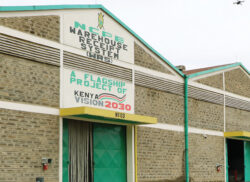
Around 14 per cent of produce worldwide is lost after harvest on farms and at the transport, storage, processing and wholesale stages, according to the Food and Agriculture Organization (FAO). This amounts to more than US$ 400 billion a year. FAO estimates that over 40 percent of food in Sub-Saharan Africa perishes before it reaches a consumer, often referred to as food loss. For Fresh Produce, this can be as high as 60 percent in Sub-Saharan Africa. About 90 percent of Kenya’s agricultural produce comes from smallholders, who don’t have the kind of cold storage solutions available to large-scale producers.
The most affected are fruits and vegetables. It is estimated that 40 per cent to 60 per cent of fruits and vegetables perish along the supply chain due to a lack of warehousing and cold chain solutions in Kenya. Most crops are only seasonally available with price variations between peak harvest and low season reaching up to 500 per cent under normal conditions.
UN Secretary-General António Guterres last year described food loss and waste as an “ethical outrage.” “In a world with enough food to feed all people, everywhere, 690 million people continue to go hungry and 3 billion cannot afford a healthy diet,” he said. Consolidated warehousing for commodities and agriculture in the value-chain reduces wastage. Modern warehouses with security and pest and temperature control could radically reduce this loss.
Warehouse Receipt System
The introduction of the Warehouse Receipt System (WRS) by the Government has been nothing short of revolutionary. First introduced to reduce post-harvest losses for cereal farmers by the National Cereals and Produce Board, the WRS now covers coffee and tea as well. WRS is a process where producers deposit their commodities in certified warehouses and are issued with a Warehouse Receipt. Its impact is massive. WRS is already credited with:
- Reducing post-harvest losses: enabling small scale farmers to participate in a modern and efficient market with standard quality and weights.
- Increasing access to finance: encouraging increased lending to the Agricultural sector by providing alternative collateral (commodity) and mitigating risk to the banks, especially for the youth and women who do not have access to traditional collaterals such as Title deeds and logbooks
- Quantity and quality: enabling small scale farmers to participate in a modern and efficient market with standard quality and weight
- Promotion of aggregation of produce by small scale farmers: enabling access to large traders, Agro-processors and value addition.
- Creating flexibility in the sale process: enabling farmers to align the sale of their commodities to favourable pricing
- Reducing price volatility and improving liquidity as the first step towards a commodity exchange and improved price discovery/stable prices
- Eliminating the gap between men, women and the youth in access to agricultural resources such as Loans.
- Access to loans for women and youth
Phase 1 roll-out of the Warehouse Receipt System in Kenya covers five NCPB Certified Warehouses in Kitale, Eldoret, Nakuru, Nairobi and Meru. The Agriculture Food Authority (AFA) directorate is tasked with carrying out inspection and certification process of NCPB stores under the Food Crops Regulations that were drafted pursuant to Section 40 of the Crops Act 2013. The requirements for warehouse standard for food storage uses a check list that has 122 check boxes as guided by Kenya standards, 2657 /2016 on warehousing and storage of bulk commodities.
Several parastatals, including the Kenya National Trading Corporation (KNTC) and New Kenya Planters Cooperative Union (KPCU) are participants in the WRS. Under the new reforms private sector is allowed to participate in the WRS as NCPB will initially have to cede at least 25 per cent of its storage capacity across the country through competitive commercial leasing. The Government has also lifted restrictions on the use of customs bonded warehouses in the country. These are warehouses licensed by KRA for the storage of imported goods pending the payment of duties.
According to the Kenya Association of Manufacturers (KAM) the country does not have the capacity to produce a wide range of imported products including lubricants, alcoholic beverages and building and construction materials. Warehousing ensures continuous production as raw materials are kept within the country rather than imported when required. It makes it possible for businesses to establish highly efficient supply chains, giving them a competitive advantage.
As these businesses grow, they create economic opportunities by creating jobs (directly and indirectly). For the companies that opt for large scale production and bulk supply, warehousing is a must. Warehousing help companies ensure quick supply of goods in demand.
